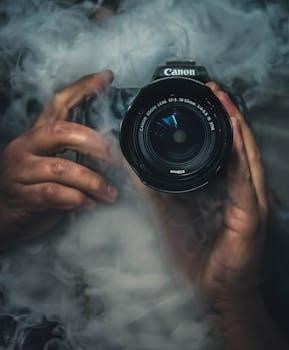The Canon AE-1 Program is a 35mm single-lens reflex film camera, released in 1981. It gained popularity amongst both amateur and professional photographers for its versatility and ease of use. As part of the AE-1 series introduced in 1976, this model offers various automatic and manual controls.
Overview of the Canon AE-1 Program
The Canon AE-1 Program is an electronically controlled 35mm SLR camera offering three primary operation modes⁚ program AE, shutter-priority AE, and manual. Program AE automatically adjusts both shutter speed and aperture. Shutter-priority AE allows the user to select the shutter speed while the camera sets the corresponding aperture. The manual mode grants full control over both settings. The camera is compatible with Canon FD lenses, enabling various photographic styles. It also offers a self-timer function and supports dedicated flash photography with the Speedlite 168A. Furthermore, this model includes features like film loading, rewinding, and a pre-shooting checklist. Care and maintenance tips are also available to ensure the longevity of the camera. The AE-1 Program’s design aimed to simplify the photographic process while providing the necessary tools for creative expression. The camera is a popular choice for those wanting a user-friendly film experience with options for manual control. Many users can find manuals online for detailed instructions and troubleshooting. The camera’s popularity means there is a good community support network available.
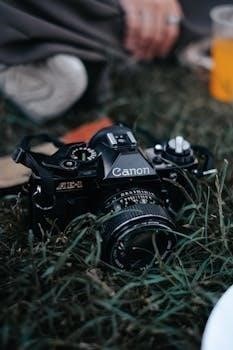
Key Features of the AE-1 Program
The AE-1 Program boasts automatic exposure modes, including program AE and shutter-priority AE. It also provides full manual control. The camera uses Canon FD lenses and has a built-in self-timer for flexible shooting.
Automatic Exposure Modes
The Canon AE-1 Program provides two primary automatic exposure (AE) modes⁚ Program AE and Shutter-Priority AE. Program AE allows the camera to automatically select both the shutter speed and aperture, simplifying the shooting process. This mode is ideal for situations where you want to quickly capture a shot without worrying about manual settings. To engage Program AE, the lens aperture ring must be set to ‘A’ and the shutter speed dial should be set to ‘Program.’ In contrast, Shutter-Priority AE allows you to select the desired shutter speed, while the camera automatically adjusts the aperture for proper exposure. This is useful when you want to control motion blur or freeze fast-moving subjects. Both AE modes rely on the camera’s internal light meter to determine the correct settings, ensuring well-exposed photographs under varying lighting conditions. These modes are enabled when using a Canon FD lens. The camera’s electronic system manages the exposure calculations. These automatic options offer convenience for various photographic scenarios, making the AE-1 Program a versatile tool for both beginners and experienced users.
Manual Control Options
Beyond its automatic exposure modes, the Canon AE-1 Program offers a robust set of manual control options for photographers who prefer greater creative command. In manual mode, you have full control over both the shutter speed and the lens aperture. This allows for precise adjustments to exposure, enabling you to achieve specific effects such as shallow depth of field or intentional over/underexposure. The shutter speed can be selected using the dial on the camera body, while the aperture is adjusted using the ring on the lens. The camera’s viewfinder provides a light meter reading, assisting in setting the correct exposure. The manual mode offers flexibility in creative expression. The AE-1 Program’s manual controls are essential for advanced techniques and customized results. Manual adjustments can be made with any lens, including non-FD lenses. The camera’s built-in light meter helps guide exposure settings. The manual mode allows users to exercise complete control over image parameters. These manual controls empower photographers to fully explore their creative vision.
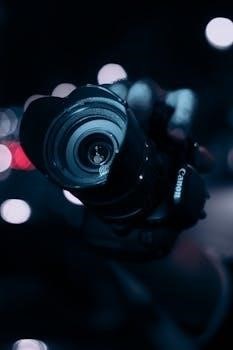
Operating the Camera
Operating the Canon AE-1 Program involves understanding its various modes. These include program mode, shutter-priority AE, and manual mode. Each mode allows different levels of control over exposure, thus catering to various user preferences and photographic needs.
Setting the Program Mode
To set the Canon AE-1 Program to program mode, begin by locating the diaphragm-setting ring on your lens. This ring is typically found near the base of the lens, where it connects to the camera body. Ensure that this ring is turned to the ‘A’ or ‘auto’ setting, which indicates that the aperture will be automatically controlled by the camera’s internal metering system. Next, find the shutter speed dial, usually located on the top of the camera body. Rotate this dial until it is set to the ‘program’ position, often designated with a ‘P’ symbol. Once both the aperture ring and the shutter speed dial are set, the camera is now in program mode. In this mode, the camera automatically sets both the shutter speed and aperture for proper exposure based on the light meter reading. This is useful for quick shooting where you want the camera to handle exposure settings. This allows the photographer to fully concentrate on the subject without worrying about manual adjustments.
Using Shutter-Priority AE
To utilize Shutter-Priority AE mode on the Canon AE-1 Program, begin by ensuring your lens is equipped with a Canon FD mount. This mode is designed to let you control the shutter speed while the camera automatically adjusts the aperture for the correct exposure. First, make sure the diaphragm-setting ring on your lens is set to ‘A’ or ‘Auto’. Then, rotate the shutter speed dial to your desired shutter speed. This dial is typically located on the top of the camera body. Once the shutter speed is set, the camera’s internal metering system will choose an appropriate aperture setting for the amount of light available. This mode is particularly helpful when you need to control the motion of the subject, whether it be freezing fast action with a higher shutter speed or adding motion blur with a slower speed. The camera will adjust the aperture accordingly to ensure a well-exposed image, allowing the photographer to focus on capturing the desired effect.
Utilizing Manual Mode
To use the Canon AE-1 Program in manual mode, you have direct control over both the shutter speed and aperture, allowing for complete creative freedom. Begin by setting the lens’ diaphragm ring to a specific aperture value, taking it off the “A” setting. Next, adjust the shutter speed dial on the camera body to your desired speed. The camera’s light meter, visible in the viewfinder, will assist you in determining the correct exposure. You should adjust either the aperture or shutter speed, watching the light meter indicator, until you reach the desired exposure. Pay attention to the meter’s needle or LED display to ensure proper light levels; overexpose by selecting a wider aperture or slower shutter speed and underexpose with a smaller aperture or faster shutter speed. This mode is useful when you are working in challenging lighting conditions, or when you want specific creative control of depth of field.
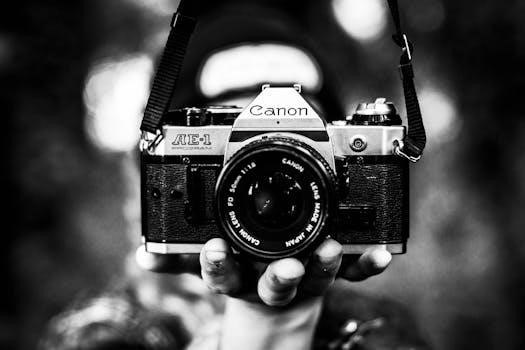
Specific Functions
The Canon AE-1 Program includes specific functions like film loading, rewinding, and self-timer operation. It also supports dedicated flash photography with the Speedlite 168A, expanding its versatility in various shooting scenarios. These features enhance the user experience.
Film Loading and Rewinding
To load film into the Canon AE-1 Program, begin by opening the camera back using the rewind knob. Insert the film canister into the film chamber, ensuring it sits correctly. Pull the film leader across the camera body and insert it into the take-up spool, aligning it with the designated markers. Advance the film lever a couple of times, ensuring the sprocket teeth engage properly with the film perforations. Close the camera back securely. Continue advancing the film until the counter displays “1”; Your camera is now ready for shooting. Rewinding is equally straightforward. After finishing your roll, press the rewind button located on the base of the camera. Then, lift the rewind crank and rotate it clockwise until the film is fully rewound into the canister. You’ll feel a slight release in tension when the film is completely rewound. Open the camera back and remove the film canister.
Using the Self-Timer
The Canon AE-1 Program includes a self-timer function, enabling you to include yourself in photos or take long-exposure shots without touching the camera. To engage the self-timer, first, make sure the camera is set to the desired exposure settings. Locate the self-timer lever on the front of the camera, usually near the lens mount, and move it to the self-timer position. Once set, press the shutter release button. The self-timer will activate, and you will have approximately ten seconds before the shutter is released. The camera’s self-timer mechanism is indicated by a flashing red light near the viewfinder. Remember that the camera needs to be mounted on a tripod to keep it from moving. Always ensure it’s stable before using the self-timer. After the shot is taken, the lever will need to be reset.
Flash Photography with Speedlite 168A
The Canon AE-1 Program is compatible with the Canon Speedlite 168A flash unit, offering enhanced lighting options for various shooting scenarios. To use the Speedlite 168A, attach it to the camera’s hot shoe, ensuring it is securely connected. When using the flash, the camera automatically sets the shutter speed to 1/60th of a second. It is crucial to select the appropriate aperture based on the distance to the subject and the flash’s guide number. The camera will indicate when the flash is ready. When using the flash, the AE-1 Program will provide an adequate exposure, but manual settings are possible for more creative control. For flash photography, the shutter speed is automatically set, but the aperture must be set manually to ensure proper exposure. Always check the flash is charged before shooting.
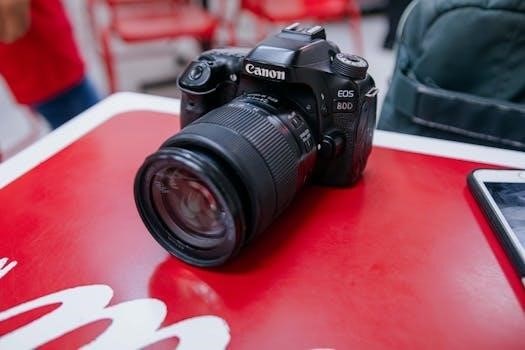
Additional Information
This section provides details on maintaining your Canon AE-1 Program. It includes guidance on troubleshooting common issues and where to locate the camera’s instruction manual. Accessing these resources ensures optimal camera performance.
Care and Maintenance
Maintaining your Canon AE-1 Program is essential for its longevity and optimal performance. Begin by regularly cleaning the camera body with a soft, dry cloth to remove dust and fingerprints; Avoid using harsh chemicals or solvents, as these can damage the camera’s finish. The lens should be cleaned with a specialized lens cleaning cloth and solution, gently wiping in a circular motion to prevent scratches. It’s also important to keep the lens free from dust and moisture when not in use, using lens caps to protect both the front and rear elements. When storing the camera, choose a cool, dry place away from direct sunlight. For long-term storage, consider removing the batteries to prevent potential damage from corrosion. Periodically check the light seals around the film compartment and replace them if they show signs of wear or deterioration. By following these simple practices, you can keep your AE-1 Program in excellent working condition for years to come, ensuring you capture memorable moments with clarity and precision.
Troubleshooting Common Issues
Encountering issues with your Canon AE-1 Program can be frustrating, but many problems have simple solutions. If the camera is unresponsive, first check the battery. Ensure it is correctly installed and has sufficient power. A common issue is the camera not advancing the film, which could be due to improper loading or a mechanical fault. Verify that the film is loaded correctly and the advance lever is working smoothly. If the light meter seems inaccurate, make sure the lens is properly mounted and the aperture ring is correctly set. If the shutter release fails to trigger, the self-timer might be engaged or the battery could be too low. Also, the shutter curtain may be stuck if the camera has not been used for a long time. Clean the battery contacts using a soft cloth if they appear corroded; If the problem persists, seeking professional assistance is recommended.
Where to Find the Manual
Locating a manual for the Canon AE-1 Program is straightforward, with numerous online resources available. Several websites offer free downloadable PDF versions of the original instruction manual, including sites dedicated to camera manuals. These resources often provide high-quality scans, making it easy to read and print the manual if needed. Additionally, some online communities and forums dedicated to vintage cameras may have links to downloadable manuals or offer assistance in finding a specific version. If you prefer a physical copy, some online retailers specializing in vintage camera accessories may sell printed versions of the manual. Remember to verify the source’s reliability before downloading any files. Also, check online marketplaces, as sellers often include a manual when selling used cameras. Always ensure the manual you download corresponds to the Canon AE-1 Program version.
